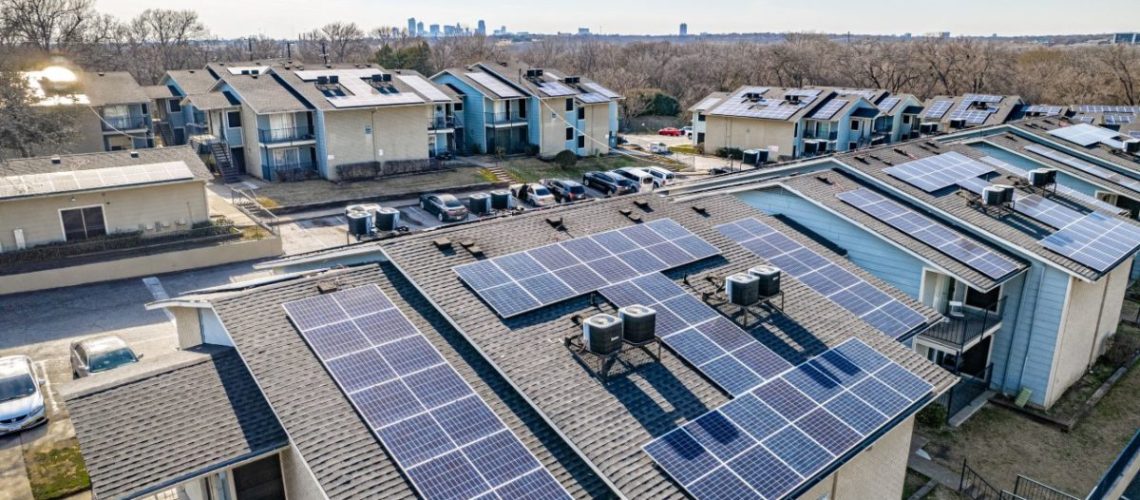VPPs represent an innovative way to efficiently use distributed solar and storage, offering savings and backup power to renters. In California, PearlX and Sunnova, among others, are launching services that connect renters with solar, backup energy storage, and bill savings.
California multifamily renters will soon have access to a variety of services classified as virtual power plants (VPPs), which connect an underserved market with clean energy, bill savings, backup power, and more.
Jigar Shah, director of the U.S. Department of Energy Loan Programs Office, wrote about VPPs in a recent issue of pv magazine:
“A VPP is a virtual aggregation of distributed energy resources like PV, energy storage, EV chargers and demand-responsive devices (such as water heaters, thermostats, and appliances). VPPs do more than provide decarbonization and grid services – they increasingly give grid operators a large-scale and utility-grade alternative to new generation and system buildout through automated efficiency, capacity support, and non-wire alternatives. By deploying grid assets more efficiently, an aggregation of distributed resources lowers the cost of power for everybody, especially VPP participants.”
Shah said that the growth of VPP is held back not by technological innovation, but lack of debt financing for unfamiliar technologies, and the ability of innovative grid-scale solutions to tap into viable business models.
One such company that has demonstrated a viable model, PearlX, self-described as a flexible energy provider, recently announced the launch of a multi-family virtual power plant (VPP) service in California.
“Project Flexifornia” is a solar and storage VPP for California renters, initially targeted for a set of 1,400 apartments across five communities in Southern California Edison (SCE) and Pacific Gas and Electric (PG&E) territories. The new VPP service follows the company’s implementation of a VPP multi-family project in Texas earlier this year.
Under the program, tenants will gain access to solar, storage, and electrification services on-site, including smart thermostats and EV charging. PearlX said renters will receive a 5% to 10% discount on electricity bills at no cost. Renters will also have the benefit of backup power via battery energy storage during grid blackouts.
The company said the platform addresses multi-family renters of all incomes. Low-income with past credit issues can access the service via a custom “non-credit” underwriting process. Property owners who participate will hold a cash-yielding asset at their housing community at no cost to them, actualized through annual lease payments from PearlX.
PearlX raised $67.2 million in a Series B funding round to scale this service. The company is now valued at $115 million.
The round was led by Lombard Odier Asset Management (USA) Corp., using funds under its management. These funds include the LOIM Sustainable Private Credit Strategy managed by Peter Pulkkinen and Rhys Marsh, which was recently backed by the Environment Agency Pension Fund (UK).
“Multi-family remains the largest unaddressed real estate segment in the U.S. for electrification and decarbonization. At 45% of the nation’s housing stock, single family renters have serious bargaining power. We are unlocking that power through participation from renters, including low-income communities, giving them what they want: energy choice, lower prices and protection from extreme weather and grid failures,” said Michael Huerta, PearlX co-founder and CEO.
Taking a different approach to VPP, Sunnova Energy International (Sunnova), an energy as a service provider, announced it plans to deploy energy from aggregated “Adaptive Homes” to alleviate grid capacity needs in a predominantly low-income area in PG&E territory in northern California.
The company said its existing portfolio of aggregated customers with solar and storage systems defers the need for PG&E to upgrade the energy distribution infrastructure at local substations. This will cost effectively extend the useful life of the existing infrastructure while accommodating customer energy demand.
PG&E said targeted areas of the distribution system will require increased capacity for only a handful of hours per year, and Sunnova’s distributed assets are well positioned to efficiently meet that need while supporting clean energy and homeowner resiliency needs.
The California Public Utilities Commission established this type of VPP program with the creation of the Distribution Investment Deferral Framework (DIDF) in 2018. Since then, CPUC has approved over 34 MW of battery storage contracts for investor-owned utilities, with 16 MW awarded in PG&E’s service area. In the past five years, the California residential market has deployed over 530 MW of battery storage systems, half of which are in PG&E’s service area.
“In September 2020, FERC Order 2222 opened the door for VPPs in the United States. Nearly two years later, VPPs are just beginning to compete in organized capacity, energy, and ancillary services markets at a meaningful scale at the regional level. To truly unlock VPP’s potential, wide reaching deployment at the national scale is needed,” said Shah.
A case study on the potential of homes with solar-plus-storage as VPP participants can be found here.



